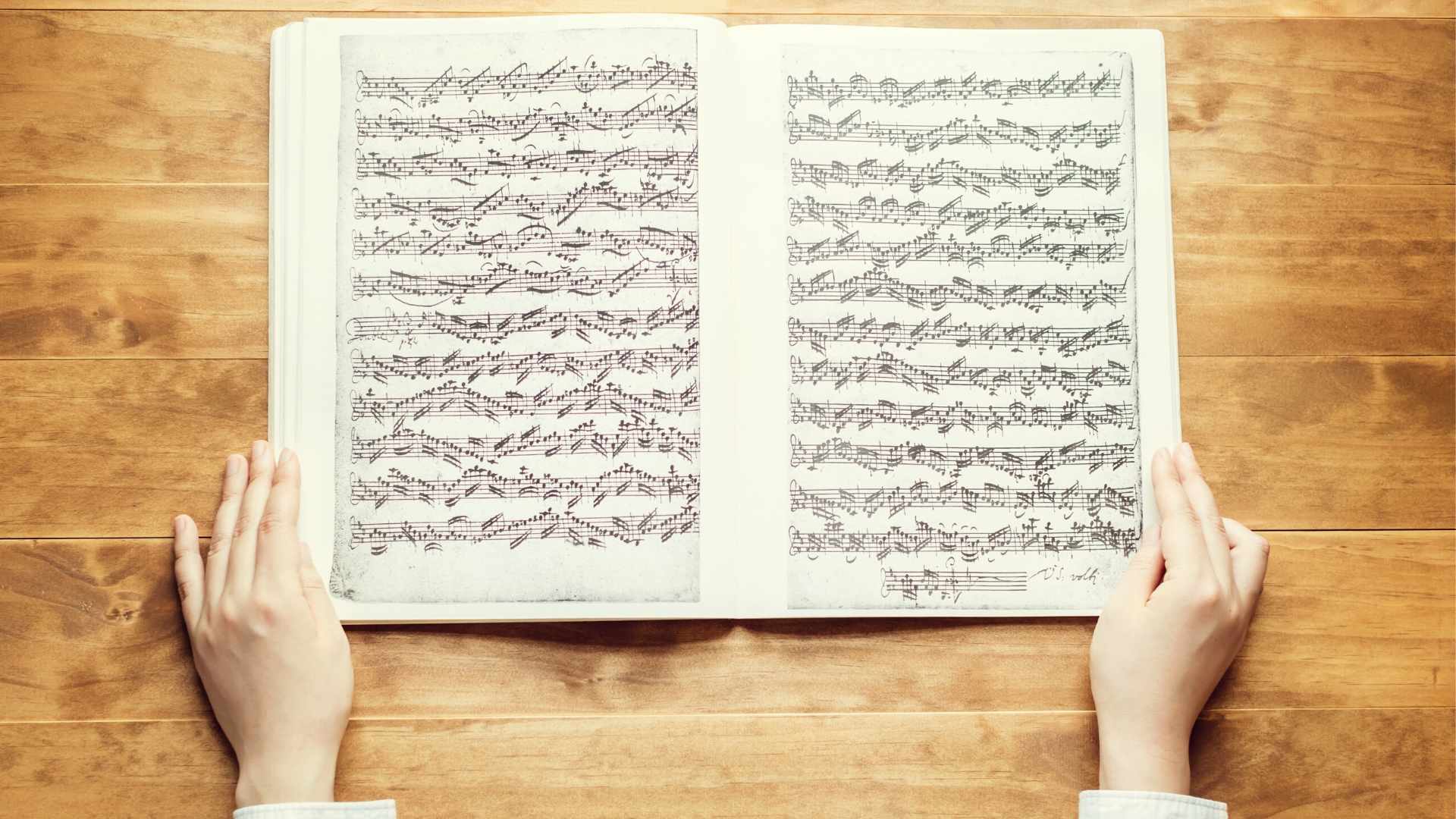How to Write Lesson Notes for Your Students
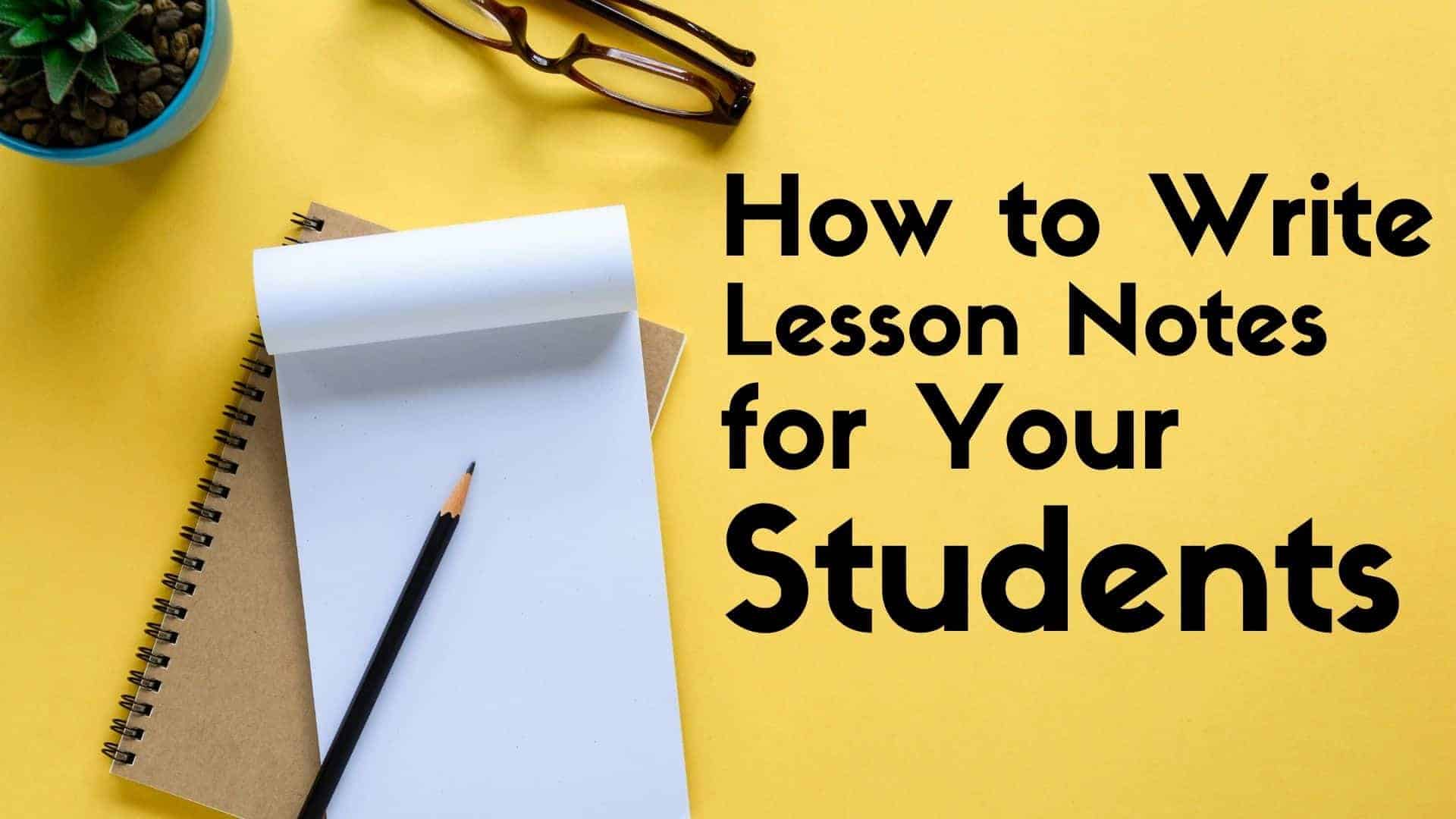
How To Write Lesson Notes For Your Students
The notes you make for your students after each lesson can sometimes be the deciding factor of how quickly they will progress on their instrument, and how well their understanding of the instrument will be. A great teacher accompanied by good notes, supported by excellent teaching methods is a powerful combination that can result in a great learning experience for the student.
How do you write good lesson notes? Well, that’s what we are going to get into in this article. I will also give you a few examples of how I write my own notes.
How long should you spend writing lesson notes?
Teachers have widely different opinions about lesson notes. Some teachers write quite long, thorough notes while other teachers don’t make notes at all. My teachers didn’t. Well, they made some scribbles in the educational book that we were using, mainly just to put the date on the piece we were playing. They also wrote some chords and theory notes in a blank sheet music book, which was quite helpful. But writing some more detailed notes about how to practise the material until the next lesson? Nope. That doesn’t seem to be the style of a lot of teachers.
In theory, tutors are not obliged to write lesson notes. Writing notes after each lesson is a bit of a grey area for a lot of tutors. If you write notes after the lesson, you give your student more time than you have been paid for. So why should you do it? You could potentially spend the last few minutes of each lesson making notes. But then you are taking up time that has been paid for just to write something down. What if you’re a slow writer?
Often, I spend ten minutes writing notes after a lesson. Sometimes more if I’m writing notes for three different students that had consecutive lessons in the same house. I would feel bad taking up 15 minutes of the lesson time to write notes. I feel much more comfortable writing the notes afterwards. I have just made it “part of my service” to spend some time after each lesson writing notes.
In my opinion, spending some extra time on your students is part of being a tutor. Tutors usually get paid quite well, and it’s a profession where you give value to someone’s life. Knowing that you’re helping someone can outweigh the fact that you are spending a bit more time than you get paid for.
The difference between online and face-to-face lesson notes
The nature of notes is different depending on if you teach online or face-to-face. Since a lot of tutors have mostly been doing online lesson these days, let’s talk a bit about the difference.
In face-to-face lessons, the tutor usually writes notes in a notebook for the student. But if you’re teaching online, you can’t do this and have to send the notes digitally.
Because of the number of online lessons I have done lately, how I make notes have changed quite a bit.
Usually, in face-to-face lessons, there is a limit to how long you can stay in your client’s house after the lessons. Since you want to finish the notes as quickly as possible, it’s easy to make some of your notes a bit brief.
When you do online lessons, you don’t have this pressure. When writing notes after online lessons, I have noticed that I take more time and make the notes a lot more thorough than regular notes. Yet another reason why online lessons take up more time than lessons done in-person.
The benefit of doing notes digitally is that you can set up a template, and you can make headings and create a style which is more appealing to the student. If there is something you need to repeat for the next lesson, you can copy and paste instead of having to write out the same again. I also find it quicker to type than to write by hand.
But even though you have the time to write thorough notes, it doesn’t mean you should use more time. For tutors who care about doing their best, it’s easy to get too carried away. Don’t take the piss. You need to respect your own time. It’s important to find a balance between writing good notes and taking care of your time. I’m sure you’ve got other things to do other than writing overly thorough notes to your students. Write what’s necessary, but don’t go too out of your way, otherwise, you’re being overly kind.
The more practise you get with writing notes, the less time it will take to write good notes. After a while, it won’t take you that long. Just stay really focused while you do it, and do it efficiently.
What should your lesson notes contain?
Depending on the teaching style, the contents of lesson notes varies from tutor to tutor.
However, I think that any good notes should at least contain the following information:
– What your student needs to practise before the next lesson.
– How they need to practise.
This is the bare minimum. It seems obvious, but a lot of teachers completely leaves out the “how”. They only focus on “what” needs to be practised.
Here is an example of the contents of more thorough notes. It’s not always necessary to include all of this, but sometimes, it can help give a better learning experience to your student:
– What to practise
– How to practise
– Why it’s important to practise certain things or to follow your instructions
– Praise/motivation/inspiration
Let’s get into a bit more detail on each point.
What to practise
This is the most obvious piece of content to include in your notes. This might include a selected number of bars from a piece you’re working on. And you might include scales, arpeggios, sight-reading practise chord progressions, technical exercises and maybe something theory related.
How to practise
This is a point a lot of teachers exclude from their notes. Some teachers only write what to practise and completely leave out how it needs to be practised.
It’s often not enough just writing “practise the first eight bars of “Beach Buggy Boogie”. This can be interpreted in so many ways. And it’s confusing for a beginner student. What does “practise” even mean? Does it mean play it once through and that’s it? Does it mean practise hands together, or separately? And what about the tempo? Are they using the right technique while playing it?
Smart practise
All good teachers know that there are certain ways to practise a piece that will make you improve quicker or better than other ways of practising. “Smart practise” will also help the student develop a good sense of what practising really is.
For example, young children need to learn that repetition is necessary to progress on their instrument. This isn’t some kind of innate knowledge they carry from birth. Repeatedly practising short sections over and over again can be a good way of developing this understanding. If you don’t write how to practise their pieces in their homework notes, your student will often assume that playing it once from beginning to end is what you mean by “practise”.
If you notice a lack of progress in your students, but their parents say “but they’re practising a lot. They’re doing everything you say”, this might be a sign that you need to rethink how you tell your student to practise.
Something that can be difficult for the teacher is that you don’t really know how your students react to your notes. If you could be a fly on their wall during all their practise sessions, you would gain a ton of valuable insight. You would then know how they read your notes (and if they read them at all) and how you could tweak your notes to capture their attention and make them follow your instructions.
But sadly that’s not possible. Instead, It might be worth asking their parents to keep an eye on them to see how they follow your notes. This is the closest you can be to being a fly on the wall. Asking your students specific questions about your notes is usually also a good idea. You won’t always get a good answer from them. But you can learn a lot about your students just by observing what their reactions are to your questions.
Why
The “why” of things is even more common for teachers to leave out – not just from their notes, but also from lessons in general.
This is a common habit, not only in music tuition but in other subjects as well. In fact, our whole education system follows the same trend – to leave out explaining to students why we need to do things a certain way.
If you never explain to your students why they should practise scales, and you only make them do it mechanically, they might end up being quite good at playing scales but have no clue as to how they can apply it to anything. What’s the joy in being able to play all those scales but not knowing all the wonderful things they can be used for?
I have often taken over grade 5 and 6 students from other teachers. They have played scales and arpeggios for years, but when I ask them to play a Bb major chord, they look at me like I’ve just asked them to play Rachmaninov’s 1st Piano Concerto.
What I asked them to do is something they have already done for several years, but since they have only followed instructions mechanically from their teacher, they have completely missed out the whole point of playing scales and arpeggios.
When I ask them: “Why do you need to play scales and arpeggios”, the best answer they can give me is something like “I need it for the exam” or “so that I can play faster”.
There is an easy way to fix this ignorance.
If they had learnt scales and arpeggios while simultaneously knowing “why” they would have been able to take so much more value from it.
It wouldn’t have taken the students longer to learn it this way. The only thing that would have been required would be a shift in their mindset while practising. Instead of just practising it mechanically they could have practised it while they were thinking about the following things:
– The shape the scale or arpeggio makes on the piano, fretboard, fingerboard or their instrument. For example, if they acknowledge the shape the arpeggio makes on the piano keyboard, they understand that it’s a chord as well.
– How the shape, chord and sound relate to other chords, scales and arpeggios.
– Acknowledging what the “dominant” of the scale or arpeggio is, and what the scale or arpeggio is the dominant of.
In other words, connect the dots and combine theory with scales and arpeggios.
A good idea is to practise scales and arpeggios in an order that nurtures the student’s understanding of how chords relate to each other. For example, if you are practising a few arpeggios in a row, make the arpeggio you are currently on be the dominant of the next arpeggios you are about to play.
The relationship between the tonic and the dominant is such an important part of understanding music. Yet, so many teachers leave it out.
An example of including the “why” of things in your notes could be to briefly explain why you want your student to play the arpeggios in this particular order.
Praise / motivation
Before using too much praise or rewards with your students you should know what effect this can have on them.
Here is an amazing article about using motivation written by the psychologist Robin Grille.
In short, what he is saying is that praise can sometimes harm the children more than being helpful, depending on how you word yourself. Before you consider including praise or motivation in your notes or lessons, I would highly recommend that you read Grille’s article. It might completely change how you speak to your students.
Be careful of using too much praise. Otherwise, your student can become too used to it and start ignoring it. Use praise when it feels natural to use it and after they have done something that would be great if they continued doing.
If you want to use motivation in your notes, try to focus on how nice and cool the music sounds. If you can help nurture the love for music in your student, you have given something remarkable to them. Even though they have exams in music, try (as much as possible) to avoid focus on that “it’s needed for the exam”. Instead, focus on the fact that it sounds good, cool or beautiful.
“Did you notice how beautiful and powerful it sounded when you used those dynamics?”.
How to write lesson notes – examples
Now for the best part of the article! I am going to give you a bunch of example notes. These are notes I have written for my own students.
Please note that these are all notes I have made for online lessons. Usually, the notes I make for lessons in-person are a bit less thorough than this.
I have colour-coded them for you:
Black text: What to practise
Blue text: How to practise
Orange text: Why
Green text: Motivation
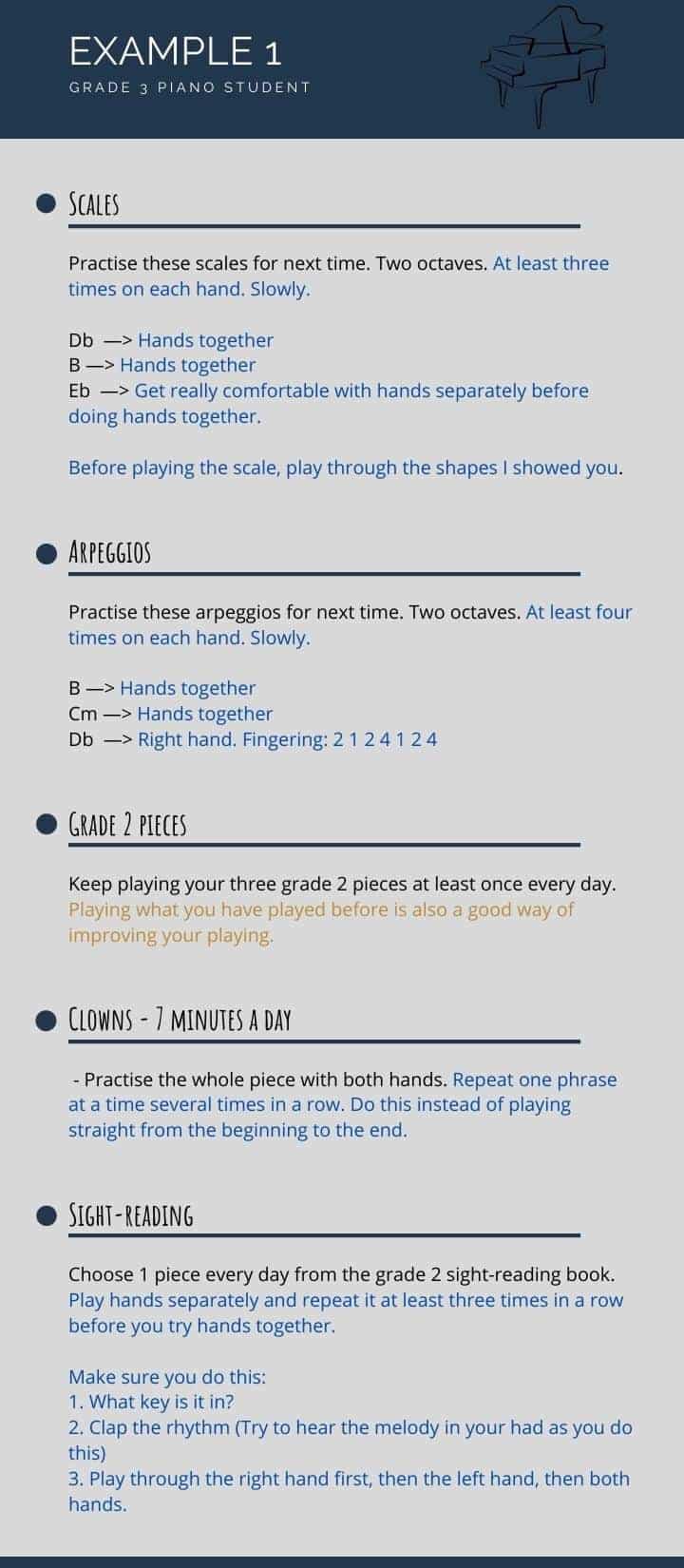
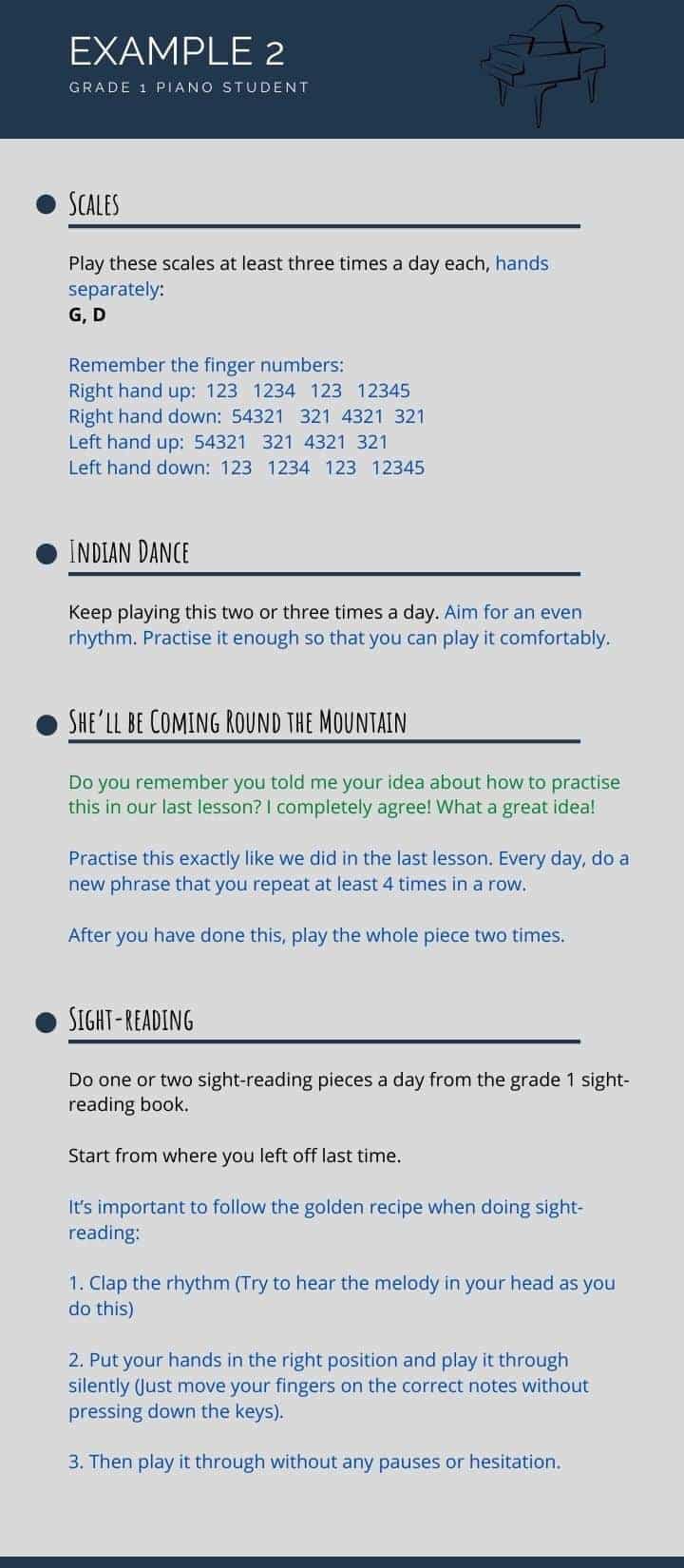

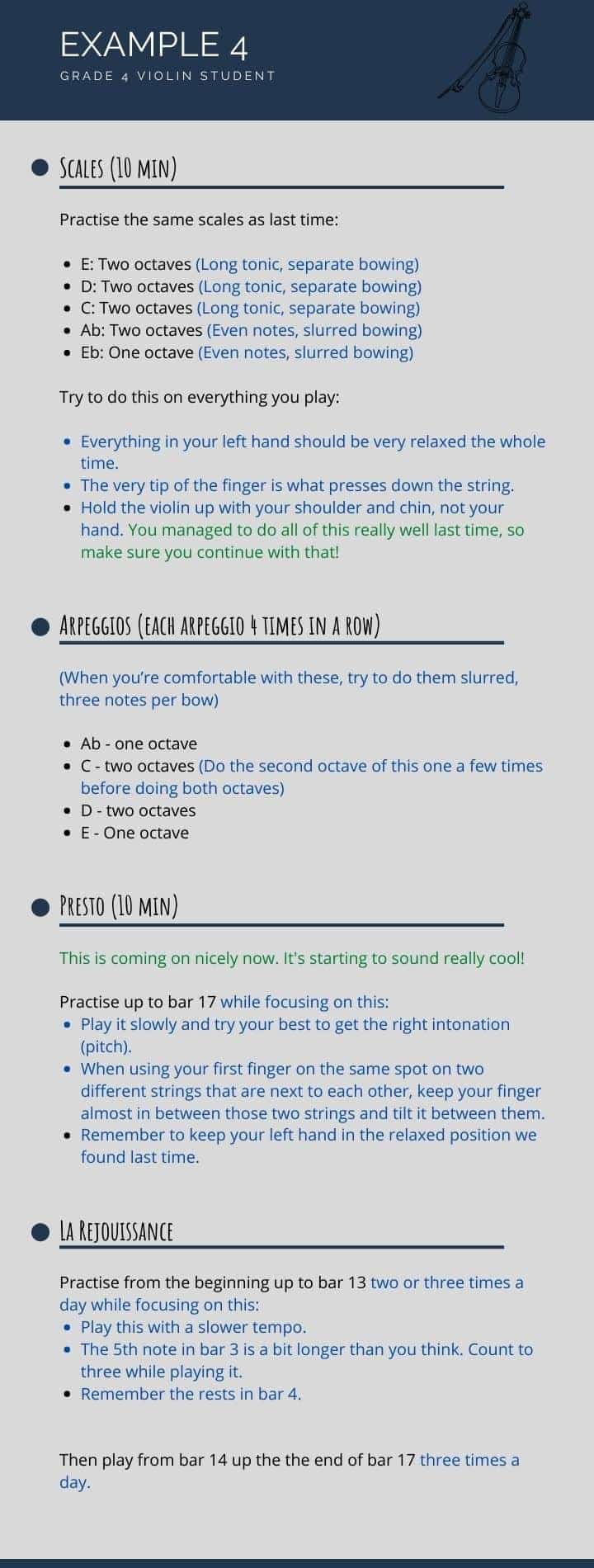
These examples should give you an idea of what your notes could contain.
If you want to read an interesting article about student notebooks, check out Sharon Mark-Teggart’s article on The Curious Piano Teachers. She’s got some amazing advice on how to pimp up your notebooks, like going digital and using Evernote.
If you found this helpful or have any comments, write a comment below. If you want to inspire other tutors, tell us how you write your own lesson notes!



